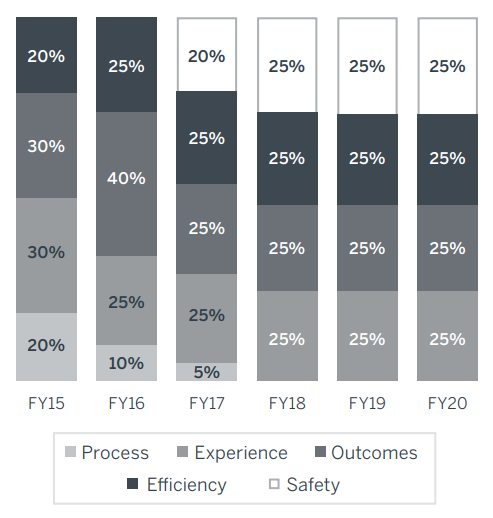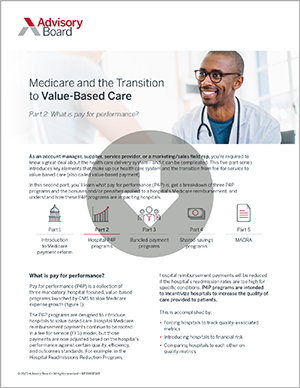Auto logout in seconds.
Continue LogoutPay for performance (P4P) programs are designed to introduce hospitals to value-based care—tying reimbursement to metric-driven outcomes, best practices, and patient satisfaction. P4P is part of the overall national strategy to transition health care to value-based medicine.
Whether you’re a field sales rep, an account executive, a medical liaison, or a customer service manager, you are expected to know a great deal about the health care delivery system—and it can be complicated.
In part two of our five-part educational series, you’ll learn what pay for performance is, get a breakdown of three P4P programs and the bonuses and/or penalties applied to a hospital’s Medicare reimbursement, and understand how these P4P programs are impacting hospitals.
Check out the below article to get a preview and download part two of our complimentary resource to learn more.
Infographic: Field Guide to Medicare Payment Innovation
What is pay for performance?
Pay for performance is a collection of three mandatory, hospital-focused, value-based programs launched by CMS to slow Medicare expense growth. Hospital Medicare reimbursement payments continue to be rooted in a fee-for-service (FFS) model, but those payments are now adjusted based on the hospital’s performance against certain quality, efficiency, and outcomes standards.
For example, in the Hospital Readmissions Reduction Program, hospital reimbursement payments will be reduced if the hospital’s readmission rates are too high for specific conditions. P4P programs are intended to incentivize hospitals to increase the quality of care provided to patients. This is accomplished by:
- Forcing hospitals to track quality-associated metrics
- Introducing hospitals to financial risk
- Comparing hospitals to each other on quality metrics
What is the Hospital Value-Based Purchasing Program?
Introduced in 2013, the Hospital Value-Based Purchasing (VBP) Program adjusts hospitals’ Medicare payments based on the hospital’s performance on a set of quality and efficiency measures. Historically, these measures have focused on five areas, with four remaining today:
- Safety
- Efficiency and cost reduction
- Clinical outcomes
- Patient and community engagement
- Process (phased out in FY17)
The weight of each of these five measures has shifted since they were first introduced in 2015. These shifts are designed to move hospitals increasingly toward rewarding value and innovations that spur better outcomes.

What are bundled payments? Learn more.
The VBP program is the only P4P program that offers potential bonuses to providers. In contrast, the Hospital Readmissions Reduction Program and the Hospital-Acquired Conditions Reduction Program carry only the threat of a penalty. To fund the VBP Program, CMS withholds a percentage of inpatient payments for each hospital. In 2019, this was 2%. However, if a hospital performs well on these VBP metrics, it can earn back that withheld amount through the bonus program. In effect, this program is budget neutral.
To learn more about the Hospital Readmissions Reduction Program (HRRP) and associated conditions, the Hospital-Acquired Condition Reduction Program, and how P4P programs are influencing hospitals, download part two of our complimentary resource, Medicare and the Transition to Value-Based Care.
Don't miss out on the latest Advisory Board insights
Create your free account to access 1 resource, including the latest research and webinars.
Want access without creating an account?
You have 1 free members-only resource remaining this month.
1 free members-only resources remaining
1 free members-only resources remaining
You've reached your limit of free insights
Become a member to access all of Advisory Board's resources, events, and experts
Never miss out on the latest innovative health care content tailored to you.
Benefits include:
You've reached your limit of free insights
Become a member to access all of Advisory Board's resources, events, and experts
Never miss out on the latest innovative health care content tailored to you.
Benefits include:
This content is available through your Curated Research partnership with Advisory Board. Click on ‘view this resource’ to read the full piece
Email ask@advisory.com to learn more
Click on ‘Become a Member’ to learn about the benefits of a Full-Access partnership with Advisory Board
Never miss out on the latest innovative health care content tailored to you.
Benefits Include:
This is for members only. Learn more.
Click on ‘Become a Member’ to learn about the benefits of a Full-Access partnership with Advisory Board
Never miss out on the latest innovative health care content tailored to you.

